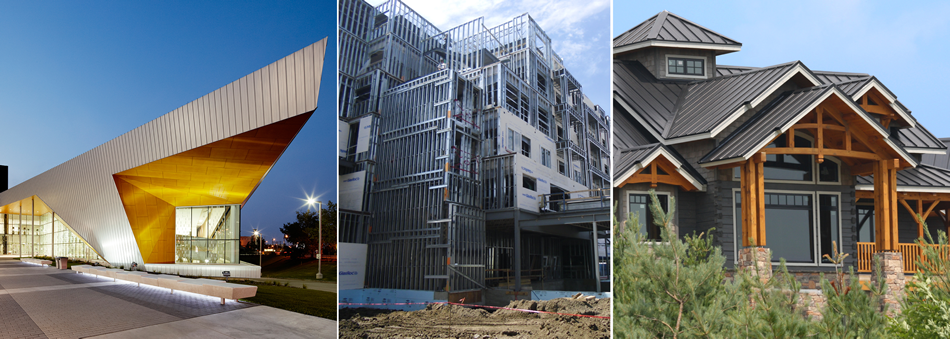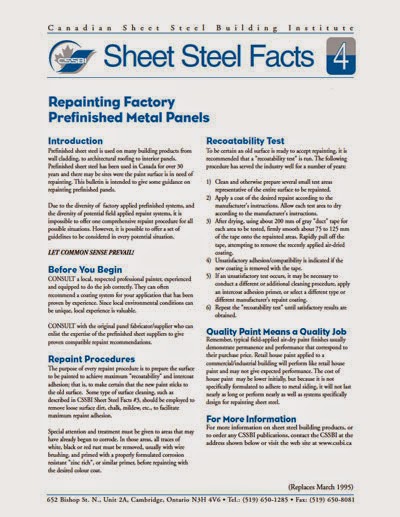Prefinished sheet steel is used on many building products from wall cladding, to architectural roofing to interior panels. Prefinished sheet steel has been used in Canada for over 30 years and there may be sites were the paint surface is in need of repainting.
Due to the diversity of factory applied prefinished systems, and the diversity of potential field applied repaint systems, it is impossible to offer one comprehensive repaint procedure for all possible situations. However, it is possible to offer a set of guidelines to be considered in every potential situation.
LET COMMON SENSE PREVAIL!
Before You Begin
CONSULT a local, respected professional painter, experienced and equipped to do the job correctly. They can often recommend a coating system for your application that has been proven by experience. Since local environmental conditions can be unique, local experience is valuable.
CONSULT with the original panel fabricator/supplier who can enlist the expertise of the prefinished sheet suppliers to give proven compatible repaint recommendations.
Repaint Procedures
The purpose of every repaint procedure is to prepare the surface to be painted to achieve maximum "recoatability" and intercoat adhesion; that is, to make certain that the new paint sticks to the old surface. Some type of surface cleaning, such as described in CSSBI Sheet Steel Facts #3, should be employed to remove loose surface dirt, chalk, mildew, etc., to facilitate maximum repaint adhesion.
Special attention and treatment must be given to areas that may have already begun to corrode. In those areas, all traces of white, black or red rust must be removed, usually with wire brushing, and primed with a properly formulated corrosion resistant "zinc rich", or similar primer, before repainting with the desired colour coat.
Recoatability Test
To be certain an old surface is ready to accept repainting, it is recommended that a "recoatability test" is run. The following procedure has served the industry well for a number of years:
Quality Paint Means a Quality Job
Remember, typical field-applied air-dry paint finishes usually demonstrate permanence and performance that correspond to their purchase price. Retail house paint applied to a commercial/industrial building will perform like retail house paint and may not give expected performance. The cost of house paint may be lower initially, but because it is not specifically formulated to adhere to metal siding, it will not last nearly as long or perform nearly as well as systems specifically design for repainting sheet steel.
- Clean and otherwise prepare several small test areas representative of the entire surface to be repainted.
- Apply a coat of the desired repaint according to the manufacturer's instructions. Allow each test area to dry according to the manufacturer's instructions.
- After drying, using about 200 mm of gray "duct" tape for each area to be tested, firmly smooth about 75 to 125 mm of the tape onto the repainted areas. Rapidly pull off the tape, attempting to remove the recently applied air-dried coating.
- Unsatisfactory adhesion/compatibility is indicated if the new coating is removed with the tape.
- If an unsatisfactory test occurs, it may be necessary to conduct a different or additional cleaning procedure, apply an intercoat adhesion primer, or select a different type or different manufacturer's repaint coating.
- Repeat the "recoatability test" until satisfactory results are obtained.
Quality Paint Means a Quality Job
Remember, typical field-applied air-dry paint finishes usually demonstrate permanence and performance that correspond to their purchase price. Retail house paint applied to a commercial/industrial building will perform like retail house paint and may not give expected performance. The cost of house paint may be lower initially, but because it is not specifically formulated to adhere to metal siding, it will not last nearly as long or perform nearly as well as systems specifically design for repainting sheet steel.










